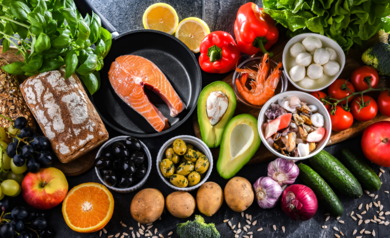- Health Conditions A-Z
- Health & Wellness
- Nutrition
- Fitness
- Health News
- Ayurveda
- Videos
- Medicine A-Z
- Parenting
- Web Stories
Pink Salt vs White Salt: What Difference Does It Make?

Credits: Canva
The pink salt trick recipe for weight loss has been recently debunked, with Health and Me, bringing out the myths that surround around the viral recipe. The TikTok-viral recipe claimed that this was a "shortcut to fat loss and metabolic reset". However, most of the videos circulated as its advertisement were either fake claims or have been made using AI or deepfake videos of celebrities who have never actually used it. Experts too have pointed out that this drink may cause harm due to its high sodium intake, which could lead to bloating than fat reduction. Others have also pointed out that the lack of iodine in pink salt could lead to thyroid disruption if it is consumed daily and substituted for the regular table salt.
Read: Harvard Gut Doctor Dispels Basil Seeds Myths You Probably Believed
Pink Salt vs Table Salt: Nutritional Comparison
Pink salt is mostly sodium chloride, like the regular table salt, however, it contains trace minerals like potassium, magnesium, and iron oxide, which gives it a pink hue. However, Dara Ford, PhD, RD, program director of the Master of Science in Nutrition Education at American University tells verywellhealth that it can increase thirst, like any other salts do. She also noted, "The presence of additional trace minerals is varied at best and does not provide more nutrients than a balanced, healthy diet."
While 'Pink Salt' is a catch-all term with its Himalayan minerals, it does not really provide the mineral it claims, but the pink hue and the claim that it is mineral-rich is what makes it commercially attractive.
Where Does Pink Salt Come From?
Pink Salt is also known as Khewra salt because it comes from Pakistan's Khewra Salt Mine, which does have trace of minerals. However, the amounts are too small to make a real difference. To equalize the benefits, one has to consume a large amount of pink salt to actually notice the benefits, which means a large amount of sodium chloride too is entering your body. This means that you might be putting yourself at risk of high blood pressure, heart disease, stroke, liver damage, osteoporosis, and kidney diseases.
By replacing regular table salt, which is fortified with iodine, one puts their health at risk.
Also Read: Pink Salt Vs White Salt, Which One Is Better?
Since pink salt is not iodized, your iodine intake may fall and cause you iodine deficiency and thyroid issues. Whereas the iodine in white salt is important for thyroid function and the consumption is enough to protect against any iodine deficiency. Individuals are only supposed to consume 1,500 mg of sodium per day while consuming salt.
What Happens In Iodine Deficiency?
- Hypothyroidism: a condition that is accompanied by goitre, as it is one of the earliest signs
- In pregnant women, it can cause neurodevelopmental deficits and growth retardation in the fetus, miscarriage or a stillbirth
- Cretinism: a condition characterized by intellectual disability, deaf mutism, motor spasticity, stunted growth, delayed sexual maturation and other physical or neurological abnormalities
- Neurodevelopmental deficits in infants can cause them to have lower-than-average intelligence as measured by IQ
- Attention deficit hyperactivity disorder in children
- Impaired mental function and work productivity secondary to hypothyroidism
- Increased risk of follicular form of thyroid cancer
Read: Why Is Iodine Important For Us?
Pink salt also typically contains less sodium. This is causing hyponatremia, a condition caused due to sodium deficiency. Research suggests that nearly 70% of individuals over sixty may be affected, yet awareness remains low. With the youth shifting to low-sodium alternatives like pink salt or Himalayan salt, the risk of low sodium is high.
Creatine: Bodybuilder's Favorite Supplement Is Now Becoming Workaholics' Go-To

Credits: Canva
Creatine, long hailed in bodybuilding circles as a must-have for muscle strength and growth, is now making waves far beyond the gym. Social media influencers, health podcasters, and even physicians are touting its potential benefits for brain health, hormonal balance, and healthy aging—prompting busy professionals and workaholics to take notice.
But while research strongly supports creatine’s athletic benefits, evidence for its wider applications remains mixed. Here’s what science says.
What Exactly Is Creatine?
Creatine is a naturally occurring compound produced in the kidneys and liver from amino acids. It fuels short, explosive movements by rapidly recycling energy in muscles. Around 95% of the body’s creatine is stored in skeletal muscle, with the rest in the brain, liver, kidneys, and heart.
Our body produce about one gram of creatine daily, while the rest must come from diet. Meat and fish are the richest sources, 225 grams of beef or salmon can provide up to 2.5 grams. This makes supplementation particularly beneficial for vegetarians, who often have lower baseline creatine levels.
Experts suggest three to five grams daily to maintain optimal muscle stores.
Proven Benefits in the Gym
Creatine’s reputation was cemented in 1992 when a landmark study confirmed that supplementation with creatine monohydrate boosts muscle creatine without harmful side effects. Since then, hundreds of studies have shown it helps athletes perform better and recover faster.
By extending the body’s energy system during high-intensity efforts, creatine allows athletes to push harder—whether it’s sprinting, lifting heavy weights, or powering through explosive moves.
A 2024 meta-analysis found that adults under 50 who combined creatine with resistance training gained significantly more strength than those who only trained. On average, lifters on creatine added an extra 4.4 kg to upper-body lifts and 11.3 kg to lower-body lifts.
However, most of these benefits were observed in men, with research in women still limited.
Brain Health and Beyond: Hype or Hope?
The new surge in interest stems from claims that creatine supports cognitive function and women’s health.
A 2003 clinical trial suggested creatine improved working memory and processing speed, sparking speculation that it could benefit older adults or those with demanding mental workloads. More recent reviews, including one in Frontiers in Nutrition, published in 2023, found moderate evidence of improved memory and faster information processing, though no significant improvements in overall accuracy.
Women’s health is another frontier. Some studies hint that creatine could help during pregnancy or menopause, when hormonal fluctuations affect energy metabolism. A review in the Journal of the International Society of Sports Nutrition linked low dietary creatine intake with higher risks of menstrual irregularities and pelvic disorders. Still, experts caution that most findings come from small or association studies, not large-scale clinical trials.
The supplement is also being explored for its role in blood sugar regulation and type 2 diabetes, but current evidence remains speculative.
How to Take It Safely
The Australian Institute of Sport recommends sticking to creatine monohydrate, the form backed by 99% of research. It is widely available, affordable, and easy to mix into water or shakes.
Most evidence supports a daily dose of three to five grams, which saturates muscle stores after about four weeks. For faster results, some use a “loading phase” of 20 grams daily for five days, followed by maintenance dosing.
While higher short-term doses may be needed for potential brain benefits, the optimal amount for cognitive support remains unclear.
Side Effects and Risks
Creatine is generally considered safe, with few reported side effects. Some users may experience stomach upset or water retention, particularly with large doses.
Concerns about kidney or liver damage have been largely debunked in healthy individuals. That said, experts recommend buying from trusted brands to avoid poor-quality supplements that could increase digestive issues.
Interestingly, up to 30% of people may see no noticeable benefits from creatine supplementation at all—a reminder that individual response varies.
Creatine’s transformation from a muscle-builder’s secret weapon to a potential “workaholic supplement” highlights how quickly wellness trends spread in the age of social media. While its benefits for athletic performance are firmly established, claims about brain health, hormonal balance, and blood sugar support remain promising but unproven.
Even With Alzheimer’s Genes, This Diet Could Lower Your Risk By 35%

Credits: Canva
What if the foods you eat today could protect your brain decades from now? A new study from researchers at Mass General Brigham, Harvard T.H. Chan School of Public Health, and the Broad Institute of MIT and Harvard suggests that following a Mediterranean-style diet could do just that—potentially lowering dementia risk by as much as 35%, even for those genetically predisposed to Alzheimer’s disease.
The Mediterranean diet, long celebrated for its heart- and longevity-promoting benefits, is now gaining attention for its protective effects on the brain. This diet emphasizes plant-based foods, healthy fats such as extra virgin olive oil, nuts, fruits, vegetables, and whole grains, with moderate fish intake. In the recent study published in Nature Medicine, researchers observed that individuals at the highest genetic risk for Alzheimer’s disease particularly carriers of the APOE4 gene variant—showed the most significant reduction in dementia risk when adhering closely to this dietary pattern.
“One reason we wanted to study the Mediterranean diet is because it is the only dietary pattern that has been causally linked to cognitive benefits in a randomized trial,” said Yuxi Liu, PhD, the study’s first author and a research fellow at Brigham and Women’s Hospital and the Harvard Chan School. “We wanted to examine whether these benefits differ among people with different genetic backgrounds and how blood metabolites may mediate this effect.”
Why Diet Important for an Aging Brain?
Brain aging begins in our 30s and 40s, subtly impacting memory, attention span, and cognitive function. Over time, neurons can accumulate toxic proteins associated with Alzheimer’s disease, and chronic inflammation accelerates cognitive decline. Nutrients in the Mediterranean diet—particularly anti-inflammatory compounds in nuts, olive oil, berries, and fish—can slow these processes, protect neurons, and preserve memory.
Fish, especially salmon and sardines, provide omega-3 fatty acids, which studies from Harvard Medical School have linked to reductions in amyloid-beta accumulation, a hallmark of Alzheimer’s disease. For those who do not consume fish, walnuts serve as an excellent source of protein and healthy fats, with research from UCLA highlighting improved cognitive outcomes from consuming roughly a handful daily. Leafy greens, berries, and coffee also feature prominently in the diet, supporting memory retention, lowering inflammation, and providing neuroprotective antioxidants.
Foods to Eat and Avoid
The study reinforced that anti-inflammatory foods are key. Meals like Greek yogurt with berries for breakfast, quinoa salads for lunch, and salmon with beans and spinach for dinner offer a template for brain-healthy eating. Conversely, diets high in sugar, salt, processed foods, and fried items—think pizza, ice cream, and hot dogs—can elevate systemic inflammation, potentially accelerating cognitive decline.
“While our research doesn’t prove a Mediterranean diet directly reduces amyloid plaque deposition, it clearly demonstrates that this dietary pattern is associated with better cognitive outcomes and slower memory loss over time,” Liu explained.
What Are The Genetic Factor for Alzheimer’s Risk?
Alzheimer’s disease has a strong genetic component, with heritability estimated at up to 80%. The APOE gene, specifically the APOE4 variant, is the most significant genetic risk factor for sporadic Alzheimer’s disease. Individuals carrying one copy of APOE4 have a three- to four-fold higher risk, while those with two copies have a twelve-fold increase in risk.
The new research demonstrated that even among APOE4 carriers, adherence to a Mediterranean diet mitigated genetic risk, emphasizing that lifestyle choices can meaningfully influence outcomes even when genetics are not in one’s favor.
To assess the interaction between diet, genetics, and cognitive health, researchers analyzed data from 4,215 women in the Nurses’ Health Study from 1989 to 2023, supplemented with 1,490 men in the Health Professionals Follow-Up Study from 1993 to 2023. Blood metabolites were examined alongside dietary questionnaires, and participants were tracked for incident dementia cases. A subset of women underwent telephone-based cognitive testing to assess memory changes over time.
The findings consistently showed that participants who closely followed a Mediterranean-style diet had slower cognitive decline and lower dementia risk, with the strongest effects among those genetically predisposed.
How Food Influences the Brain?
Beyond inflammation reduction, the study explored metabolites—small molecules that indicate how the body processes nutrients. These metabolites may modulate pathways involved in brain health, including lipid metabolism, oxidative stress, and energy production. By influencing these pathways, a Mediterranean diet could exert a systemic neuroprotective effect, particularly in individuals with high genetic susceptibility.
“Targeting specific metabolic pathways through diet may eventually allow personalized interventions for dementia prevention,” Liu noted.
Are There Any Limitations to Consider Before?
While the results are compelling, the study cohort was primarily well-educated individuals of European ancestry, highlighting the need for research in more diverse populations. Additionally, genetics and metabolomics are not yet integrated into most clinical risk models for Alzheimer’s disease, and many people do not know their APOE status. Future research aims to expand these findings into broader, personalized dietary recommendations and explore whether specific metabolites can be targeted to reduce cognitive decline further.
How To Eat for a Healthy Brain?
Even without genetic testing, adopting a Mediterranean-style diet offers measurable cognitive benefits. Key practices include:
Prioritizing plant-based foods, healthy fats, and whole grains
Add fish or omega-3-rich alternatives like walnuts
Consuming berries, leafy greens, and moderate coffee
Limiting processed, sugary, and fried foods
As science increasingly links nutrition to brain health, these lifestyle strategies provide actionable ways to protect cognition, even for those at elevated genetic risk.
Alzheimer’s may have strong genetic roots, but diet emerges as a powerful, modifiable factor. This study underscores the potential of the Mediterranean diet not only to reduce dementia risk by up to 35% but also to slow age-related cognitive decline, offering hope that what we eat today can shape our brains for decades to come.
Could Omega-3 Fatty Acids Be The Dietary Fix For Your Kids Nearsightedness?

Credits: Canva
If your child spends hours glued to screens, you’ve probably worried about their eyesight. But here’s something surprising, could a nutrient as simple as omega-3 help protect them from nearsightedness? A new study says yes—and the findings might change how parents think about everyday nutrition and eye health.
omega-3 fatty acids have been touted for their potential to promote heart health, reduce inflammation, and even guard the brain. They're what make salmon, walnuts, and chia seeds so well-touted as "superfoods." But scientists are now discovering another intriguing possibility: omega-3s might help guard vision too.
Nearsightedness, or myopia, is on the verge of becoming the most prevalent child health problem in the world. It's no longer out of the ordinary for a kid to receive their first eyeglasses before the age of ten. An estimated nearly half of the world's population may suffer from myopia by the year 2050. Heredity has something to do with it, but so does lifestyle—particularly during an era of digital screens, restricted outside playtime, and an unbalanced diet.
The question researchers are raising is- Does what children eat make a quantifiable difference in the way their eyes grow? Based on new research released in the British Journal of Ophthalmology, the answer may be yes.
The research, conducted by Dr. Jason Yam, a professor of ophthalmology at the Chinese University of Hong Kong, monitored over 1,000 children aged 6 to 8. Researchers monitored their diets via questionnaires and compared them with comprehensive eye examinations. Here's what they discovered:
Youngsters with the lowest intake of omega-3 fatty acids had the longest axial length (from front to back of the eye). A longer axial length is associated with myopia directly.
Children with a greater intake of omega-3 had the shortest axial length, indicating a shield against nearsightedness.
Individuals with greater intake of saturated fats—found in foods such as butter, palm oil, and red meat—had a more pronounced indication of developing myopia.
Simply put, kids who consumed more omega-3s were less likely to exhibit the physical eye changes that cause nearsightedness.
Dr. Yam and his researchers concluded that omega-3s could be "a potential protective dietary factor against myopia development."
What Is Nearsightedness or Myopia?
Nearsightedness results when the form of the eye leads light rays entering the eye to converge ahead of the retina, instead of directly on it. This causes objects in the distance to blur.
The condition usually arises during childhood and stabilizes by adulthood, but its complications can stretch much further than the prescription for glasses. High myopia raises the risk of retinal detachment, glaucoma, and cataracts in later life. Changes in lifestyle in today's world are driving its increase:
- Increased screen time and less exposure to natural light outdoors
- Sedentary lifestyles and less physical activity
- Nutritional deficits that impact bone and eye growth
The new research indicates that omega-3s could directly affect eye growth, perhaps by enhancing blood supply and maintaining a healthy retinal and corneal growth.
How Omega-3s Helps Protect Vision?
Omega-3 fatty acids are essential nutrients that the body is unable to generate by itself and, therefore, need to be obtained from diet. They come in three forms: ALA (alpha-linolenic acid), present in vegetable sources such as walnuts, flaxseeds, chia seeds, and hemp seeds; DHA (docosahexaenoic acid), a brain and retina structural component crucial to health, present mainly in fish, algae, and other sea foods; and EPA (eicosapentaenoic acid), which is present in fish and algae as well, notable for its anti-inflammatory effect.
Of these, DHA is particularly vital to eye function and development. One of the richest tissues in DHA, the retina has been found through human and animal research to have compromised vision from deficiencies in early life. New evidence now indicates that the role of omega-3s is not limited to cardiac and neurological well-being but could also play a protective function in maintaining the vision of children through formative developmental years.
How do Parents Assist in Precluding Myopia in Children?
Across the world, nearsightedness rates are rising at alarming rates. By 2050, almost 5 billion individuals will be myopic. The increase is particularly steep in East Asia, where intense schooling pressures, prolonged near vision work, and diet changes overlap but Western nations are following fast. More screen time for kids, less outdoor time, and processed food diets rich in saturated fats have provided an ideal environment for eye issues.
If left unchecked, myopia's burden will stress health systems and impact quality of life for millions. Prevention measures—such as dietary interventions—are therefore critical.
Other Health Benefits of Omega-3s
This is not the first instance that omega-3s have been associated with eye wellness. Earlier studies have identified that they can lower the risk of:
Age-related macular degeneration (AMD) is a common cause of blindness among older adults
Dry eye disease: Omega-3s may enhance tear quality and alleviate inflammation
- In addition to eye care, omega-3s are linked with:
- Reduced risk of heart disease
- Enhanced brain function and reduced dementia risk
- Improved mood and alleviated depression symptoms
- Lessened inflammation in the body
Another study published by King's College London has recently discovered that omega-3s may also lower the risk of Alzheimer's in women, further highlighting their wide-ranging protective benefits.
How to Add Omega-3 Rich Foods in Your Diet?
For households wishing to enhance children's omega-3 levels, diet is the key.
Oily fish: Salmon, mackerel, sardines, and tuna are richest in DHA and EPA.
Plant sources: Walnuts, chia seeds, flaxseeds, and hemp seeds contain ALA, which the body can partially convert into DHA and EPA.
Algae-based supplements: A vegetarian option for those following a plant-based diet.
Experts advise that children consume at least two portions of fish every week, although supplements can be beneficial in instances of diet limitations or fussy eating.
Why Balance Is Important in Your Diet?
Although omega-3s seem to be protective, the research also points out what not to excess: saturated fats. Diets rich in processed meats, butter, and palm oil were linked with higher indicators of myopia in children.
Diet is only one part of the equation. Outdoor activity, reduced screen time, and frequent eye exams are all just as crucial in safeguarding children's vision.
The new study doesn't show omega-3s can prevent nearsightedness outright, but it provides strong evidence that nutrition is involved in eye development. For caregivers and parents, it's another reminder that what kids eat influences not only how they grow up, but how they experience the world literally.
As Dr. Yam's group points out, omega-3s are turning out to be a "potential protective dietary factor against myopia development." Whether in a piece of grilled salmon or a handful of chia seeds, increasing the family diet with more omega-3s may be a practical, easy solution to healthier eyes.
© 2024 Bennett, Coleman & Company Limited

